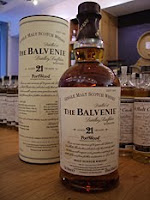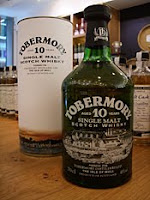 Balvenie is located in the famous whisky town of Dufftown in the Speyside region of Scotland. It is one of the largest and most famous scotch whisky distilleries in Scotland with an annual production level of 5.5 million litres. Balvenie is still owned by the original founders, William Grant & Sons, and was built in 1892 to help their other overworked distillery at Glenfiddich. Balvenie is next door to Glenfiddich and is a unique distillery. They have their own floor maltings (a room used for the germination of the barley), a cooperage where they construct casks and they even grow some of the barley used in the distillery grounds.
Balvenie is located in the famous whisky town of Dufftown in the Speyside region of Scotland. It is one of the largest and most famous scotch whisky distilleries in Scotland with an annual production level of 5.5 million litres. Balvenie is still owned by the original founders, William Grant & Sons, and was built in 1892 to help their other overworked distillery at Glenfiddich. Balvenie is next door to Glenfiddich and is a unique distillery. They have their own floor maltings (a room used for the germination of the barley), a cooperage where they construct casks and they even grow some of the barley used in the distillery grounds.Each year over 1.5 million bottles of Balvenie are sold across the world, putting it well inside the top 10 for total sales. All aspects of the Balvenie brand - its popularity and core range - continues to grow. The core range currently includes two 12 year olds (one called Doublewood and the other called Signature), a 15 years old from a single barrel, this 21 years old which has been part matured in a Port wine cask and a 30 years old. Other limited editions appear regularly and they also have some bottlings exclusive for the duty free travel market.
The colour of this Balvenie 21 years old Portwood is golden amber with a noticeable reddish tinge. The nose is highly aromatic with a powerful mixture of characteristics - ripe dark fruit, nuts (think of almonds), caramel, dried zest (especially orange), warm spice (imagine cinnamon and ginger) and something woody and waxy (think of sandalwood and wax furniture polish). On the palate, this is equally as complex. It feels silky and buttery in the mouth with sweet vanilla, toffee, honey and cereal grains combining with darker elements such as brown sugar (think of moscavado or molasses), woody spice (imagine cinnamon and nutmeg), dark and slightly bitter dried red fruit (raisins especially). The problem is that it is almost too complicated and it is only with a dash of water that the intensity eases up. Then it becomes much easier to drink with more fruit (think of red grapes and sultanas) and more vanilla and yeasty creaminess appearing. The finish is long, rich and creamy with honey, molasses, dried fruits and nuts (a slightly more bitter nut this time, like a walnut) prominent. It begins sweet (almost sugary) before turning and becoming pleasantly dry and a touch bitter.
Balvenie 21 years old Portwood is an extremely enjoyable and well balanced whisky, especially when water is added. It is very complex and hard to get in to at times, but it is worth working through these this. This is an excellent example of a good cask finished whisky as the Port cask used in maturation has added numerous positive elements to the whisky. Portwood can be found in specialist whisky retailers at 40% ABV and at 47.5% ABV in duty free travel retailers. A bottle should cost £75-85.









 Tobermory is the only distillery on the island of Mull, which lies a short ferry ride from the west Highland coast of Scotland. It was founded in 1798, making it one of Scotland's oldest distilleries and is named after the small town of Tobermory on the island. Tobermory is small and compact with an annual production capacity of one million litres and is currently owned by Burn Stewart Distillers. The whisky produced there is popular with blenders and this means that only around 15% of Tobermory's whisky is released as single malt. The most popular blended whisky that uses Tobermory is
Tobermory is the only distillery on the island of Mull, which lies a short ferry ride from the west Highland coast of Scotland. It was founded in 1798, making it one of Scotland's oldest distilleries and is named after the small town of Tobermory on the island. Tobermory is small and compact with an annual production capacity of one million litres and is currently owned by Burn Stewart Distillers. The whisky produced there is popular with blenders and this means that only around 15% of Tobermory's whisky is released as single malt. The most popular blended whisky that uses Tobermory is 





